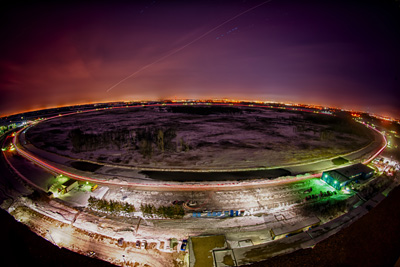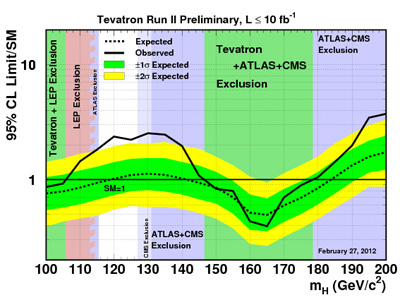Fermilab and the Higgs Boson
Tevatron Experiments: CDF and DZero
Searching for the Higgs required colliding particles at high enough energies to produce other particles, essentially recreating the conditions of the early universe shortly after the big bang. The hunt for the Higgs included experiments at the Large Electron-Positron Collider at European laboratory CERN, and continued at Fermilab when its Tevatron accelerator took its turn as the most powerful particle collider in the world.
Two experiments – CDF and DZero, the collaborations for which included more than 1,200 physicists from universities and laboratories around the world – used the Tevatron’s high energies to search for the Higgs boson.
Theorists had a good idea about many of the properties of the Higgs boson, but the hardest to predict was its mass. Much of the work conducted at the Tevatron advanced the search for the Higgs boson by eliminating mass ranges not previously excluded at LEP, while also looking for signs of where the Higgs might be. On July 2, 2012, scientists on the Tevatron experiments, combining their data, presented strong indications for the production and decay of Higgs bosons, based on a decay mode of the Higgs boson which was not seen at the LHC. But it took results from the LHC experiments to establish a discovery.
Facts
- Number of countries involved in the CDF experiment: 15.
- Number of countries involved in the DZero experiment: 18.
- At top speeds, particles cycled through the Tevatron about 48,000 times per second.
- CDF stands for Collider Detector at Fermilab. DZero was named after the detector’s location on the accelerator ring.
- Particles collided inside each detector more than 2 million times per second.
- The Tevatron was capable of reaching energies as high as 1 TeV (or one trillion electron volts) in each of the two colliding beams, hence the accelerator’s name.
Links
- Tevatron site
- Tevatron legacy page
- Tevatron interactive timeline
- Press release: Tevatron experiments double-team Higgs boson (Aug. 2008)
- Press release: Fermilab experiments narrow allowed mass range for Higgs boson (July 2010)
- Press release: Precision measurements lead to stricter Higgs limits (March 2011)
- Article from symmetry: Tevatron experiments close in on Higgs particle (July 2011)
- Press release: Tevatron sees hints of Higgs boson (March 2012)
- Press release: Tevatron scientists announce final results on Higgs particle (July 2012)
- Last modified
- 04/28/2014
- email Fermilab



